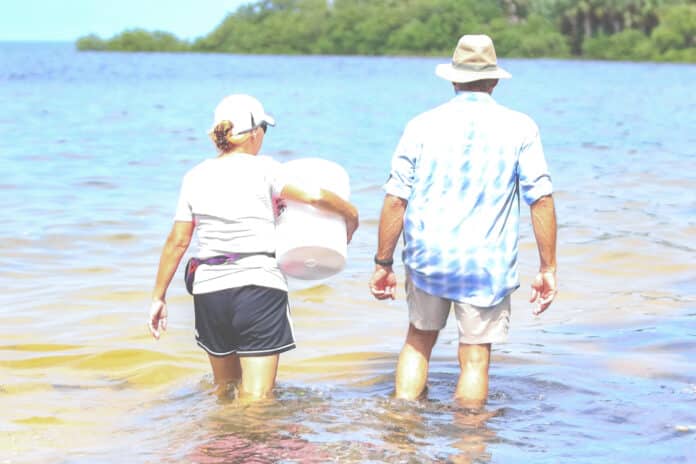On September 13, 2019 the University of Florida/IFAS Extension at Hernando County offered a training program for participation in the Horseshoe Crab Watch Citizen Science Program. Volunteers had the opportunity to learn about the program and especially about horseshoe crabs, which are not crabs. They are closely related to spiders and other arachnids. We all reacted the same way. See what you can learn when you volunteer!
Horseshoe crabs play a significant role in nature as a food source for many marine life species. As their habitat decreases, the population begins to decline. This program helps document information for marine biologists who have some area of involvement, whether it may be researching for conservation or other agencies.
For the next couple of months during high tide, these marine life creatures are in their mating season, and during this time, it’s the best opportunity for surveying.
Measuring, weighing, determining age, sex, and noting any shell damage is part of the documentation. Tagging horseshoe crabs are the only way of tracking their movement, breeding, as well as their lifespan.
Brittany Hall-Scharf, UF/IFAS Extension Hernando County, Marine Agent II is the only marine agent ever to hold that position in Hernando County. And what she does is important to not only provide educational resources in Hernando County but to research the many marine life species that thrive along the county’s coastline.
“I work on a lot of the marine-related research education projects,” Brittany said. “There’s a lot of data missing. We ran into that with our oyster reef project. There weren’t any previous studies published for us to use as references.”
This program started last year and has given Brittany a starting point to compare data that they gathered from previous surveys. However, she can’t do this alone. She couldn’t do this without the help of volunteers.
Volunteering is a great way to learn and provide much-needed help towards projects like the horseshoe crab watch. The best way of learning is the hands-on approach.
“I found reaching people on the educational side of things is usually better accepted when you involve them. They get to learn a little bit more and interact with that project,” Brittany said.
“There is a need to understand how many males or females (horseshoe crabs) that are out there, what’s adding back into the population, where are they breeding,” she continued. “Involving volunteers helps get those answers.”
Last year 47 horseshoe crabs were tagged. As far September 16, volunteers have tagged 30, and there are still twelve more tagging dates to conduct.
Of course, there are always onlookers who are curious — wondering why these strange creatures are being collected and placed into 5-gallon buckets and they aren’t shy to ask what is going on.
“I like how interested people are,” Brittany said. “They want to learn more about what you are doing, and it gives you that teaching opportunity.”
Recently there has been more documentation in the Tampa Bay area as well as Cedar Key. Hernando County can further provide valuable data collection for the Horseshoe Crab Watch Citizen Science Program.
“I think it’s pretty cool, just being one of the projects that’s ground-truthing. That what you are doing is adding to the knowledge of the species itself,” Brittany said.
Interested in being a part of this program? Contact:
Brittany Hall-ScharfMarine Agent II
UF/IFAS Extension Hernando County @ (352) 754-4433
Learn more about the program visit: https://ncbs.ifas.ufl.edu/extension/florida-horseshoe-crab-watch/
Learn more about horseshoe crabs visit: https://myfwc.com/research/saltwater/crustaceans/horseshoe-crabs/

